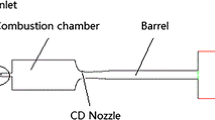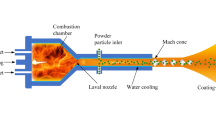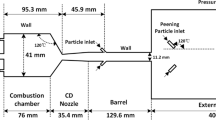Abstract
This paper analyzes the behavior of coating particle as well as the gas flow both of inside and outside the High-Velocity Oxy-Fuel (HVOF) thermal spraying gun by using quasi-one-dimensional analysis and numerical simulation. The HVOF gun in the present analysis is an axisymmetric convergent-divergent nozzle with the design Mach number of 2.0 followed by a straight passage called barrel. In the present analysis it is assumed that the influence of the particles injected in the gas flow is neglected, and the interaction between the particles is also neglected. The gas flow in the gun is assumed to be quasi-one-dimensional adiabatic flow. The velocity, temperature and density of gas in the jet discharged from the barrel exit are predicted by solving Navier-Stokes equations numerically. The particle equation of motion is numerically integrated using three-step Runge-Kutta method. The drag coefficient of the particle is calculated by linear interpolation of the experimental data obtained in the past. Particle mean temperature is calculated by using Ranz and Marchalls’ correlation for spherical particles. From the present analysis, the distributions of velocity and temperature of the coating particles flying inside and outside the HVOF gun are predicted.
Similar content being viewed by others
References
Schlichting, H. Boundary-Layer Theory. 7th Ed.. McGraw Hill, 1979. 621
Bailey, A B, Hiatt, J. Sphere Drag Coefficient for a Broad Range of Mach and Reynolds Numbers. AIAA J., 1972, 10(11): 1436–1440
Ranz, W E, Marshall, W R Jr. Evaporation from Drops, Part I. Chem. Eng. Prog., 1952, 48(3): 141–146
Hackett, C M, Settles, G S. The Influence of Nozzle Design on HVOF Spray Particle Velocity and Temperature. Proceedings of the 8th National Thermal Spray Conference. Houston, Texas, 1995. 135–140
Yee, H C. Upwind and Symmetric Shock-capturing Schemes. NASA TM-89464, 1987
Thompson, K W. Time Dependent Boundary Conditions for Hyperbolic Systems II. J. Compt. Phys., 1990, 89: 439–461
Sobolev, V V, Guilemany, J M, Calero J A. Prediction of Powder Particle Behavior During High-velocity Oxy-fuel Spraying. J. Thermal Spray Technology, 1995, 4(3): 287–296
Author information
Authors and Affiliations
Rights and permissions
About this article
Cite this article
Katanoda, H., Matsuo, K. Analysis of particle behavior in High-Velocity Oxy-Fuel thermal spraying process. J. of Therm. Sci. 12, 279–282 (2003). https://doi.org/10.1007/s11630-003-0083-z
Issue Date:
DOI: https://doi.org/10.1007/s11630-003-0083-z




